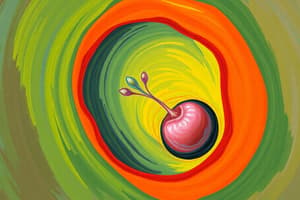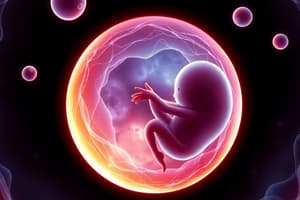Podcast
Questions and Answers
Shortly after fertilization the zygote divides through mitosis into two ______
Shortly after fertilization the zygote divides through mitosis into two ______
blastomeres
Pregnancy begins at ______ and carries forward for 38 weeks
Pregnancy begins at ______ and carries forward for 38 weeks
fertilization
Testing for Pregnancy: Pregnancy tests are testing for the hormone human chorionic gonadotropin (hCG). This hormone is secreted by the ______
Testing for Pregnancy: Pregnancy tests are testing for the hormone human chorionic gonadotropin (hCG). This hormone is secreted by the ______
syncytiotrophoblast
Most common first sign of pregnancy is a missed ______ cycle
Most common first sign of pregnancy is a missed ______ cycle
Implantation generally begins between day 7-10 post-fertilization, involving trophoblast invasion and the deciduoma response.
Implantation generally begins between day 7-10 post-fertilization, involving trophoblast invasion and the deciduoma response.
The ______, formed around day 3-4 after fertilization, consists of a fluid-filled chamber and a layer of cells that will develop into the embryo.
The ______, formed around day 3-4 after fertilization, consists of a fluid-filled chamber and a layer of cells that will develop into the embryo.
The process of pregnancy involves sequential stages such as fertilization, implantation, ______, fetal development, labor, and birth.
The process of pregnancy involves sequential stages such as fertilization, implantation, ______, fetal development, labor, and birth.
The ______, formed through several divisions, is a solid ball of cells surrounded by the zona pellucida from the original oocyte.
The ______, formed through several divisions, is a solid ball of cells surrounded by the zona pellucida from the original oocyte.
The ______ system's response to fetal tissues involves the detection of foreign cells through histocompatibility proteins on white blood cells.
The ______ system's response to fetal tissues involves the detection of foreign cells through histocompatibility proteins on white blood cells.
The ______, derived from fetal and maternal tissues, facilitates gas and waste exchange between the developing fetus and the carrier.
The ______, derived from fetal and maternal tissues, facilitates gas and waste exchange between the developing fetus and the carrier.
Early embryonic development involves the differentiation of the pre-embryo into two tissue layers and ______, creating the three primary germ layers.
Early embryonic development involves the differentiation of the pre-embryo into two tissue layers and ______, creating the three primary germ layers.
Embryonic membranes, including the yolk sac, amnion, allantois, and ______, play essential roles in supplying blood cells to the embryo and forming the placenta.
Embryonic membranes, including the yolk sac, amnion, allantois, and ______, play essential roles in supplying blood cells to the embryo and forming the placenta.
Exchange between the fetus and carrier is limited to molecules less than ______, creating microchimerism and potential links to autoimmune disorders.
Exchange between the fetus and carrier is limited to molecules less than ______, creating microchimerism and potential links to autoimmune disorders.
Pregnancy and Fetal Development - Determining the ______ of a pregnancy relies on understanding the starting point and is crucial for medical consultations.
Pregnancy and Fetal Development - Determining the ______ of a pregnancy relies on understanding the starting point and is crucial for medical consultations.
In twin pregnancies, differences exist in the formation of placentas and amnions, and genetic ______ affects the expression of imprinted genes depending on their source (egg or sperm).
In twin pregnancies, differences exist in the formation of placentas and amnions, and genetic ______ affects the expression of imprinted genes depending on their source (egg or sperm).
Early pregnancy ______ involve assessing medical history, genetic concerns, and conducting various diagnostic tests.
Early pregnancy ______ involve assessing medical history, genetic concerns, and conducting various diagnostic tests.
What hormone are pregnancy tests testing for, and where is this hormone secreted from?
What hormone are pregnancy tests testing for, and where is this hormone secreted from?
What are some common signs of pregnancy?
What are some common signs of pregnancy?
What is the initial structure formed shortly after fertilization, and what process does it undergo to eventually implant into the endometrium?
What is the initial structure formed shortly after fertilization, and what process does it undergo to eventually implant into the endometrium?
How is pregnancy typically defined and what are the different stages of pregnancy referred to as?
How is pregnancy typically defined and what are the different stages of pregnancy referred to as?
Explain the process of implantation during pregnancy.
Explain the process of implantation during pregnancy.
What are the sequential stages of pregnancy?
What are the sequential stages of pregnancy?
What are the roles of embryonic membranes in pregnancy?
What are the roles of embryonic membranes in pregnancy?
What are the potential effects of exchange between the fetus and carrier?
What are the potential effects of exchange between the fetus and carrier?
What are the differences in twin pregnancies regarding the formation of placentas and amnions?
What are the differences in twin pregnancies regarding the formation of placentas and amnions?
What is the morula in the context of pregnancy?
What is the morula in the context of pregnancy?
What is the blastocyst and when is it formed?
What is the blastocyst and when is it formed?
What happens during early embryonic development?
What happens during early embryonic development?
What is the role of the placenta in pregnancy?
What is the role of the placenta in pregnancy?
What is the response of the immune system to fetal tissues?
What is the response of the immune system to fetal tissues?
What is essential to consider in early pregnancy medical appointments?
What is essential to consider in early pregnancy medical appointments?
What is the potential impact of pregnancy on medical consultations?
What is the potential impact of pregnancy on medical consultations?
Flashcards are hidden until you start studying
Study Notes
Pregnancy and Fetal Development
- Determining the timing of a pregnancy relies on understanding the starting point and is crucial for medical consultations.
- Early pregnancy medical appointments involve assessing medical history, genetic concerns, and conducting various diagnostic tests.
- The process of pregnancy involves sequential stages such as fertilization, implantation, embryogenesis, fetal development, labor, and birth.
- The morula, formed through several divisions, is a solid ball of cells surrounded by the zona pellucida from the original oocyte.
- The blastocyst, formed around day 3-4 after fertilization, consists of a fluid-filled chamber and a layer of cells that will develop into the embryo.
- Implantation generally begins between day 7-10 post-fertilization, involving trophoblast invasion and the deciduoma response.
- The immune system's response to fetal tissues involves the detection of foreign cells through histocompatibility proteins on white blood cells.
- Early embryonic development involves the differentiation of the pre-embryo into two tissue layers and gastrulation, creating the three primary germ layers.
- Embryonic membranes, including the yolk sac, amnion, allantois, and chorion, play essential roles in supplying blood cells to the embryo and forming the placenta.
- The placenta, derived from fetal and maternal tissues, facilitates gas and waste exchange between the developing fetus and the carrier.
- Exchange between the fetus and carrier is limited to molecules less than 500 molecular weight, creating microchimerism and potential links to autoimmune disorders.
- In twin pregnancies, differences exist in the formation of placentas and amnions, and genetic imprinting affects the expression of imprinted genes depending on their source (egg or sperm).
Pregnancy and Fetal Development
- Determining the timing of a pregnancy relies on understanding the starting point and is crucial for medical consultations.
- Early pregnancy medical appointments involve assessing medical history, genetic concerns, and conducting various diagnostic tests.
- The process of pregnancy involves sequential stages such as fertilization, implantation, embryogenesis, fetal development, labor, and birth.
- The morula, formed through several divisions, is a solid ball of cells surrounded by the zona pellucida from the original oocyte.
- The blastocyst, formed around day 3-4 after fertilization, consists of a fluid-filled chamber and a layer of cells that will develop into the embryo.
- Implantation generally begins between day 7-10 post-fertilization, involving trophoblast invasion and the deciduoma response.
- The immune system's response to fetal tissues involves the detection of foreign cells through histocompatibility proteins on white blood cells.
- Early embryonic development involves the differentiation of the pre-embryo into two tissue layers and gastrulation, creating the three primary germ layers.
- Embryonic membranes, including the yolk sac, amnion, allantois, and chorion, play essential roles in supplying blood cells to the embryo and forming the placenta.
- The placenta, derived from fetal and maternal tissues, facilitates gas and waste exchange between the developing fetus and the carrier.
- Exchange between the fetus and carrier is limited to molecules less than 500 molecular weight, creating microchimerism and potential links to autoimmune disorders.
- In twin pregnancies, differences exist in the formation of placentas and amnions, and genetic imprinting affects the expression of imprinted genes depending on their source (egg or sperm).
Studying That Suits You
Use AI to generate personalized quizzes and flashcards to suit your learning preferences.




